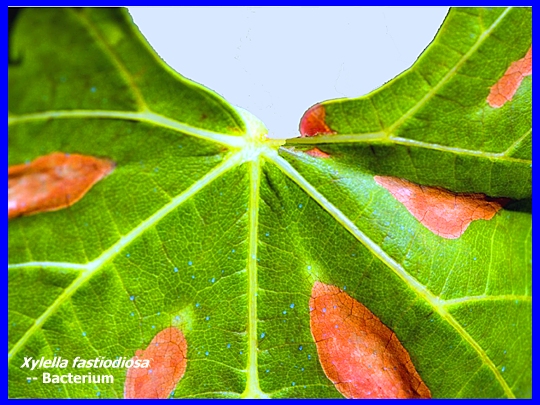FILE: <ch-120.htm> GENERAL INDEX [Navigate to MAIN MENU
]
|
PIERCE’S DISEASE Xylella fastiodiosa -- Bacterium (Contacts) ----- CLICK on Photo to enlarge &
search for Subject Matter with Ctrl/F. GO TO ALL: Bio-Control Cases
According to Dr. Mark S. Hoddle of the University of California,
classical biological control of the leafhopper may be the most effective
method of suppressing the threat
(Hoddle 2002) Mymarid egg
parasitoids in the genus Gonatoceras are considered promising
candidates for introduction. Two
species, G. iriguttatus (from Texas) and G. fasciatus (from
Louisiana) have thus far been liberated for establishment. Additional species are being sought to
curb this extremely important threat to the wine industry. However, successful classical biological
control of a vector insect such as the Glassy-winged sharpshooter is not very
probable because only a single individual insect can transmit the
bacterium. To reduce the vector
populations to a very low level with a group of insects such as leafhoppers
has never been accomplished in similar situations (e.g., beet curly top
vectors in the American West). Yet,
some seemingly unlikely candidates for biological control have been reduced
successfully by continuous effort in searching for effective natural enemies
(e.g., navel orangeworm on almonds by bethylid parasitoids).
By the year 2008 it has become evident that only certain plant species
are susceptible to the bacterium. For
example, among the oleanders, only the white-flowering varieties succumb to
the bacterium: the pinks, reds,
magentas and other varieties that bear colored blossoms are immune. This raises the possibility that in the
grapes a similar resistance may be observed.
Nevertheless, a close scrutiny of the problem as it develops is
essential. REFERENCES: [Additional references may be found at: MELVYL
Library ] Hoddle, M. S. 2002. Applied Biological Control. The Buzz, UC Riverside, Dept. of
Entomology Newsletter. 1-2. [Also contact Sergei Trjapitzin at serguei@mail.ucr.edu ] |
